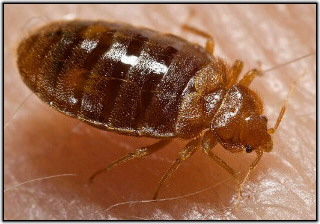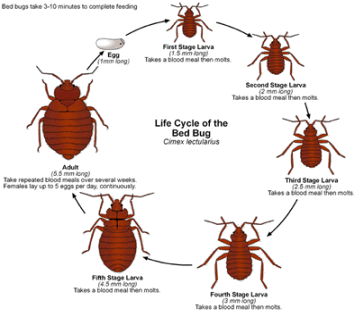Bed Bugs

The bed bug is an old pest that was common in homes prior to World War II. For the last 50 years, bed bugs have rarely been seen outside of cramped living quarters and less than sanitary conditions in jails and homeless shelters. Not anymore. In the last five years, there has been resurgence. Bed bugs have become a particular problem in hotels, motels, and hostels where there is a high rate of occupant turnover. Even five-star hotels are having problems with bed bugs. Bed bugs can’t fly, so they either crawl or are carried from place to place. Bed bugs or their eggs can hitchhike in a traveler’s suitcase or clothing. Business people now routinely travel to and from countries where bed bugs are common, even in good hotels. The offspring of one pregnant female bed bug that crawls out of a suitcase can infest a room, and eventually other rooms nearby.
Bed bugs usually feed at night and spend the day hidden. Their flattened shape lets them squeeze into narrow places in bed frames, headboards, in bedside furniture, behind pictures and switch plates, behind baseboards, under buttons on mattresses, in box springs, and in other cracks and crevices.
A bed bug feeds about once a week, usually for several minutes. It most often feeds on a sleeper’s exposed skin. The bite is nearly painless and is not felt by most people. Some people have no reaction afterwards, but most people develop a hard bump with a whitish centre which can itch for days. Although bed bugs suck blood like other human parasites, there has been no evidence that they spread diseases. Bed bugs can survive for several months between blood meals if there is no person or animal for them to feed on.
Effective Control of Bed Bugs

Introduction
Long considered eradicated in most metropolitan areas, bed bugs are making a comeback. They are being found in cities across the country, everywhere from homeless shelters to five-star hotels. Contrary to popular belief, the presence of bed bugs does not indicate a lack of cleanliness.
Why Have Bed Bugs Returned?
In the past, insecticides such as DDT helped to keep the bed bug population at bay with residues that continued working after the product was sprayed. Now, with the increase in use of bait traps instead of broad spectrum sprays, specific pests such as ants and cockroaches are being targeted, and bed bugs are no longer being eliminated.
In addition, people now travel more than ever before. Places that see a great deal of turnover such as hotels give bed bugs the opportunity to travel to new locations on luggage or clothing.
Why are Bed Bugs a Problem?
Bed bugs are nuisances and are generally off-putting to people, but they do not pose any major health risks. As with mosquitoes, people can be allergic to their bites, which can cause swelling, itchy welts and in some cases infections. However, they are not known to carry any blood-borne diseases. Bed bugs are mainly active at night. As they typically feed when people are sound asleep, their bites may not be detected immediately. One species of bed bug feeds primarily on humans, but there are other species that feed on other mammals and on birds. Bed bugs are moved into and around a dwelling through infested furniture and bedding. They can also enter a home or hotel by being carried in on clothing or luggage.
Identifying Bed Bugs
Bed bugs have an oval body and a short, broad head. The body as a whole is broad and flat. Unfed adults are around 6 to 10mm long, brown and wingless. After feeding, they swell slightly in size and darken to a blood-red colour. The nymphs are shaped like the adults, but are yellow-white in colour.
Itchy welts on skin, blood spots on sheets and/or black or brown spots on mattresses, bed frames or walls often indicate that there is a bed bug infestation.
Bed bugs are also known by several names: wall louse, house bug, mahogany flat, red coat, crimson ramblers as well as others.
Lifecycle

Eggs
The bed bug eggs are white and about one mm long, and almost impossible to see on most surfaces. The female bed bug lays about 200 eggs in her lifetime, at a rate of about three or four per day. The eggs have a sticky coating and are deposited in cracks and crevices, behind woodwork and similar hidden locations. They hatch in six to 17 days.
Nymphs
Newly hatched nymphs feed as soon as food is available. A bed bug goes through five moults before it reaches full maturity.
Adults
Adults usually live for around 10 months, but can live for a year or more. In a home, where the environment is conducive to their reproduction (their ideal breeding temperature is between 21° to 28°C), bed bugs can breed year round. Bed bugs are wingless and cannot fly or jump, but are able to enter into extremely small locations in the home because of their flattened bodies. Bed bugs can live for several weeks to several months without feeding, depending on the temperature. They can go without feeding for 80 to 140 days; older bed bugs can go without feeding longer than younger ones. Adults have been known to survive for as long as 550 days (over a year and a half!) without feeding.
What You Can Do Around Your Home
 Bed bugs are small and can hide in a myriad of places—under wallpaper, behind picture frames, in electrical outlets, inside box springs, in mattress pads, in night tables. You must be very thorough in order to properly address bed bug infestations. As bed bugs can travel up to 30m and can be transported in clothing, luggage or other household items, you may have to treat nearby rooms to prevent the infestation from continuing.
Bed bugs are small and can hide in a myriad of places—under wallpaper, behind picture frames, in electrical outlets, inside box springs, in mattress pads, in night tables. You must be very thorough in order to properly address bed bug infestations. As bed bugs can travel up to 30m and can be transported in clothing, luggage or other household items, you may have to treat nearby rooms to prevent the infestation from continuing.
If you suspect that you have a bed bug infestation, you can either choose to treat them yourself or you can call in a professional Pest Control Operator. Infested areas should be vacuumed carefully with a brush attachment, and the bag should be disposed of immediately afterwards. When inspecting your bed, examine the seams, tufts and crevices of the mattress, box spring, bed frame and headboard carefully. Bed bugs prefer wood and fabric to metal or plastic. Mattresses and box springs should be steam-cleaned. Mattresses can be wrapped in zippered bed encasements, available from allergy supply companies, or wrapped and sealed in plastic film. Mattress pads and sheets should be washed in hot water and dried on the high setting. You may have to remove the cloth underside of the box spring to determine if there are bed bugs inside.
Bed bugs cannot easily climb metal or polished surfaces, and they cannot fly or jump, so treating the legs of beds will help keep them away. Coat the legs with double-sided carpet tape or petroleum jelly. You can also place the legs of the bed inside a bed bug interceptor such as a ClimbUp, available from most pest control companies.
Treating a bed effectively can be quite challenging. Holes or worn spots in the fabric may allow bed bugs to lay eggs in areas not easily reached, and there are restrictions on how insecticides can be used on beds. Carefully examine all night tables, baseboards, dressers, headboards (especially padded ones), electrical outlets, any items stored near or under the bed, any nearby carpeting or rugs, picture frames, switch plates, inside clocks, phones, televisions and smoke detectors—in short, anything and everything that is in the room where the infestation has been noted. Upholstered chairs and sofas can also harbour bed bugs and should be treated with careful vacuuming and laundering of all possible parts (cushions, slipcovers, skirts, etc.).
Controlling Breeding Sites
Any clutter must be reduced or removed entirely. Bed bugs hide in miniscule areas, and any belongings left lying around provide a perfect opportunity for them to hide and continue to breed. Affected bedding and clothing should be bagged and laundered on the high setting, or discarded, as these products cannot be treated by the application of insecticides.
Smaller items that cannot be laundered can sometimes be treated through heating (temperatures greater than 50°C) or freezing. Some items can be wrapped in plastic wrap and placed outdoors on a hot, sunny day or in sub-zero temperatures in the winter. However, the freezing temperatures must be maintained for a prolonged period of time (e.g., two days of cold exposure at 0°C) to ensure that the bed bugs are killed. Trying to raise or lower the temperature in your entire house or apartment will not work to kill the bed bugs.
Vacuuming can be helpful in removing bugs and eggs from carpet, mattresses, walls and other surfaces. It is very important to pay close attention to seams, tufts and edges of mattresses and box springs, and the outer edge of wall-to-wall carpeting. Steam cleaning carpeting can also be effective in killing bugs and eggs not picked up by regular vacuuming.
While bed bugs prefer to feed on humans, they can and will feed on other mammals and birds. Some bed bug species are parasites of bats or birds and may bite people if the wild hosts are not available. If bat bugs or bird bugs are involved, roosting and nesting sites should also be treated, and the animals excluded from the building.
In addition, be cautious about taking in second-hand furniture, bedding, mattresses or beds. At the very minimum, these items should be carefully inspected before being brought into the home in order to protect you and your family.
Chemical Control Methods
Domestic class products available to homeowners will generally contain the active ingredient pyrethrin or diatomaceous earth. Always read the label carefully and be certain that the product purchased is registered for use against your particular pest problem. Care should be used when using pesticides, as many may not be suitable for fabrics, wallpaper, woods or other surfaces due to staining or potential contamination.
Also, several commercial class products are available to professional Pest Control Operators. These may include low-odour sprays, dusts or aerosols; your Pest Control Operator will select the best product for your particular situation.
Note that bed bug infestations can be challenging to treat, and repeat applications may be required. Always follow the label directions on the pesticide to minimize exposure and maximize efficacy of the product. Between applications of pesticide products, use integrated pest management techniques to physically control ongoing or future infestations. These techniques can be found in the Controlling Breeding Sites section above.

